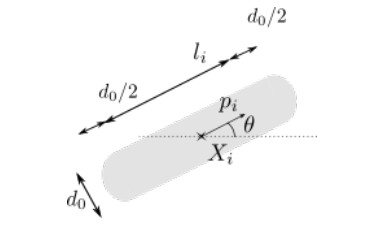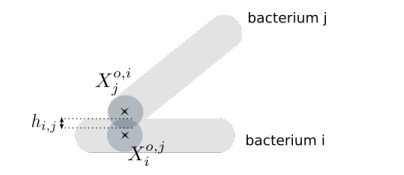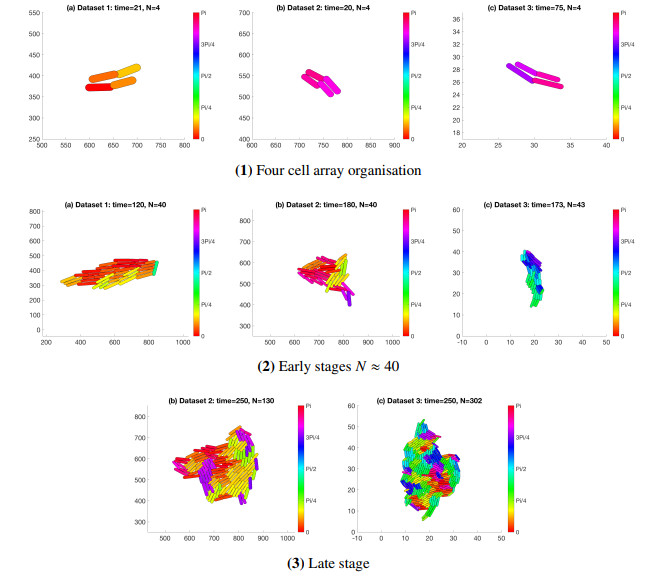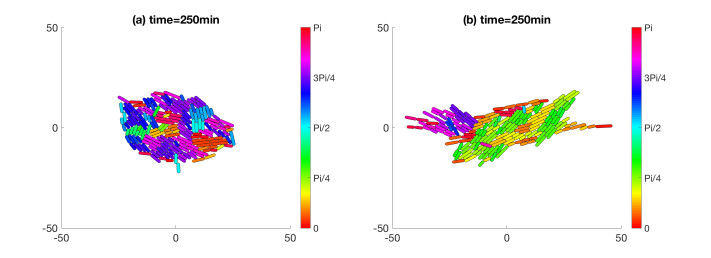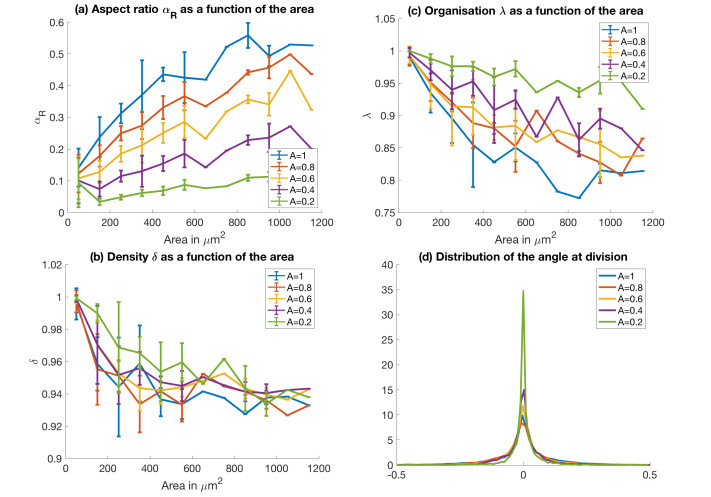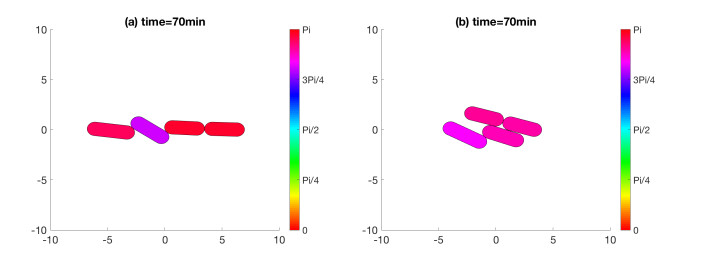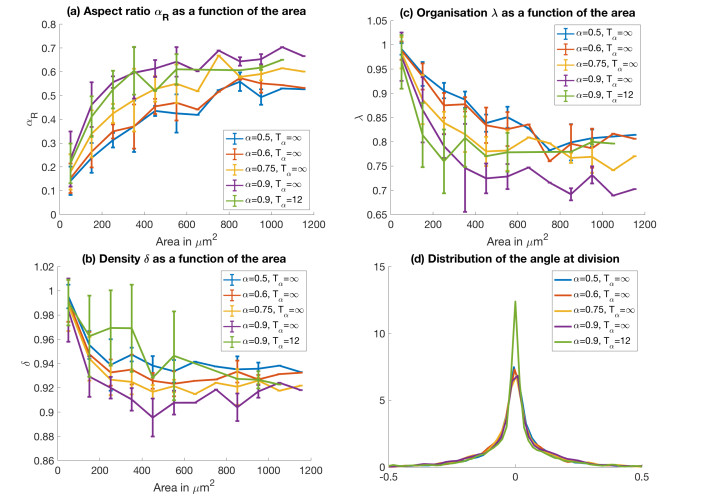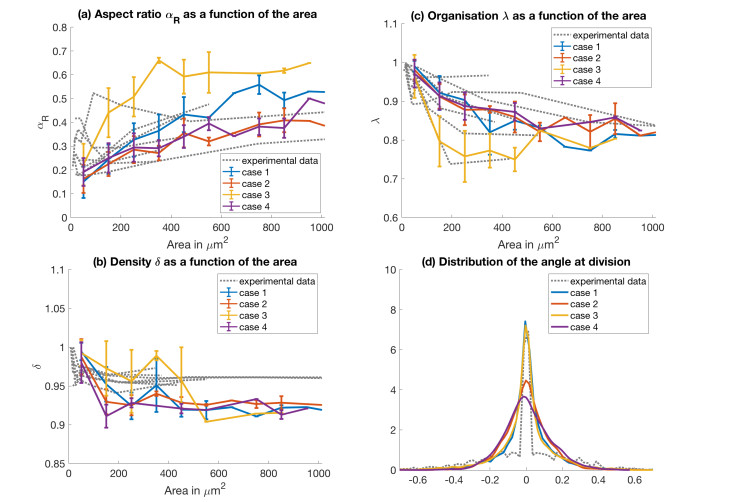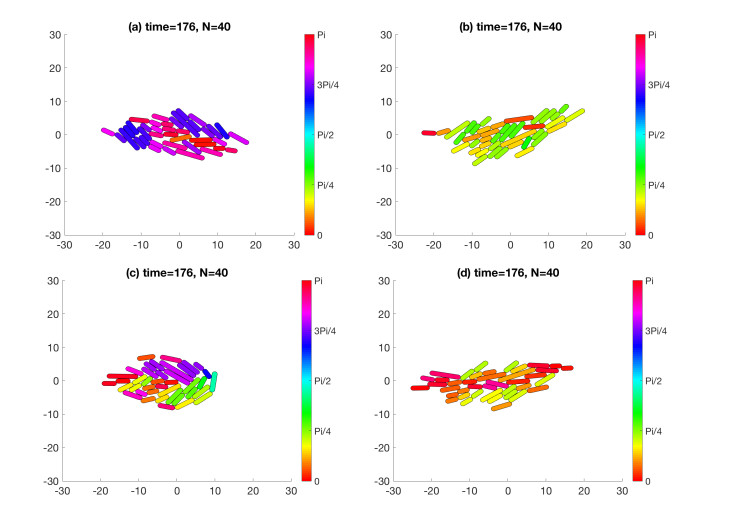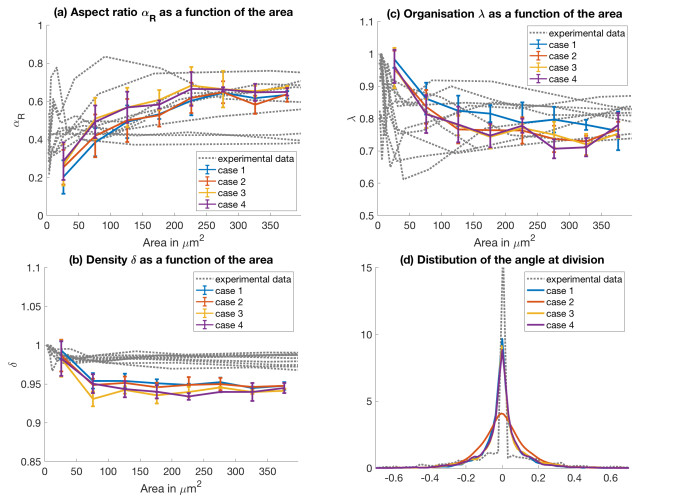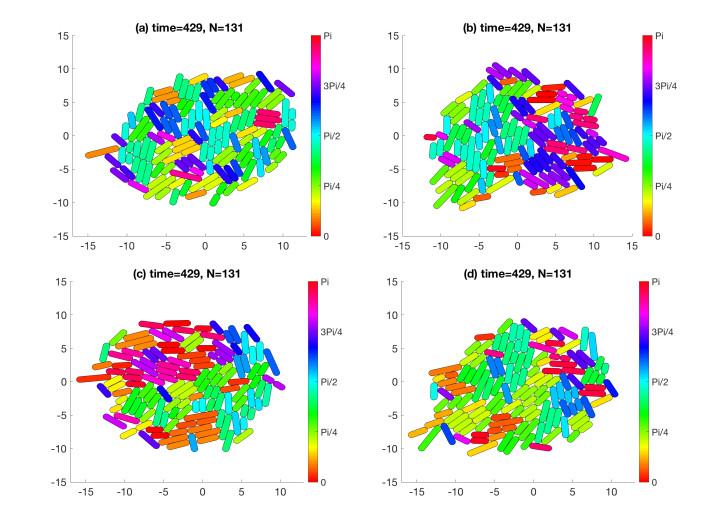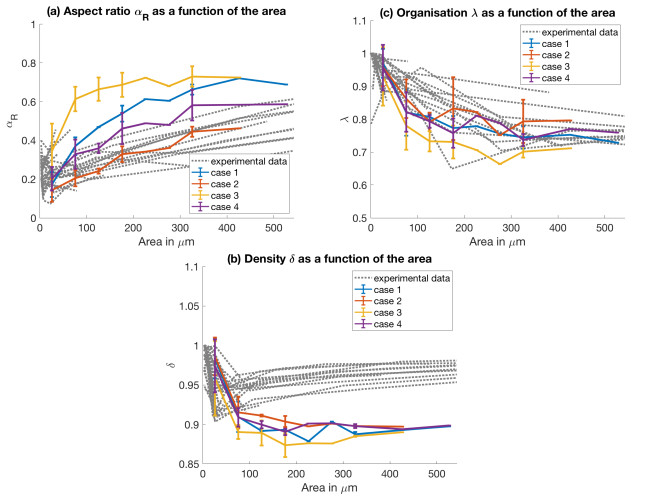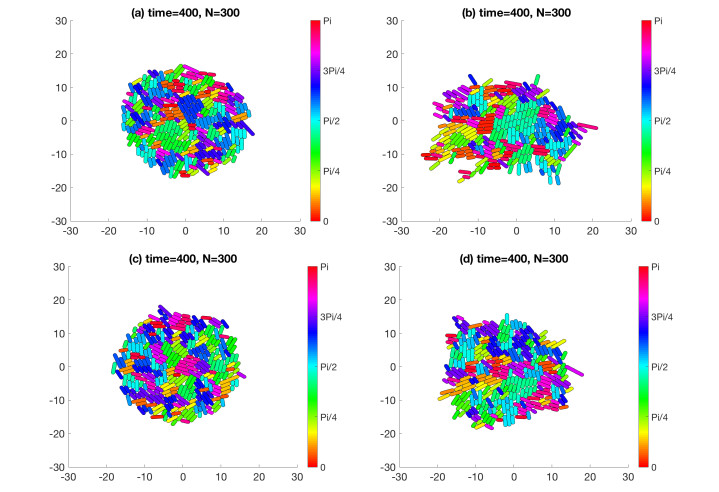|
[1]
|
M. C. Duvernoy, T. Mora, M. Ardré, V. Croquette, D. Bensimon, C. E. A. Quilliet, Asymmetric adhesion of rod-shaped bacteria controls microcolony morphogenesis, Nat. Commun., 9 (2018), 1120.
|
|
[2]
|
P. Ghosh, J. Mondal, E. Ben-Jacob, H. Levine, Mechanically-driven phase separation in a growing bacterial colony, PNAS, 112 (2015), E2166.
|
|
[3]
|
Z. You, D. J. G. Pearce, A. Sengupta, L. Giomi, Geometry and mechanics of microdomains in growing bacterial colonies, Phys. Rev. X, 8 (2018), 031065.
|
|
[4]
|
D. Boyer, W. Mather, O. Mondragón-Palomino, S. Orozco-Fuentes, T. Danino, J. Hasty, et al., Buckling instability in ordered bacterial colonies, Phys. Biol., 8 (2011), 026008.
|
|
[5]
|
D. Volfson, S. Cookson, J. Hasty, L. S. Tsimring, Biomechanical ordering of dense cell populations, PNAS, 105 (2008), 15346-15351.
|
|
[6]
|
H. Jönsson, A. Levchenko, An explicit spatial model of yeast microcolony growth, MMS, 3 (2005), 346-361.
|
|
[7]
|
M. A. A. Grant, B. Wacław, R. J. Allen, P. Cicuta, The role of mechanical forces in the planarto-bulk transition in growing escherichia coli microcolonies, J. R. Soc. Interface, 11 (2014), 20140400.
|
|
[8]
|
T. Storck, C. Picioreanu, B. Virdis, D. J. Batstone, Variable cell morphology approach for individual-based modeling of microbial communities, Biophys. J., 106 (2014), 2037-2048.
|
|
[9]
|
H. Cho, H. J?nsson, K. Campbell, P. Melke, J. W. Williams, B. Jedynak, et al., Self-organization in high-density bacterial colonies: Efficient crowd control, PLoS Biol., 5 (2007), e302.
|
|
[10]
|
D. Dell'Arciprete, M. L. Blow, A. T. Brown, F. D. C. Farrell, J. S. Lintuvuori, A. F. McVey, et al., A growing bacterial colony in two dimensions as an active nematic, Nat. Commun., 9 (2018), 4190.
|
|
[11]
|
A. Doostmohammadi, M. F. Adamer, S. P. Thampi, J. M. Yeomans, Stabilization of active matter by flow-vortex lattices and defect ordering, Nat. Commun., 7 (2016), 10557.
|
|
[12]
|
G. Ariel, A. Shklarsh, O. Kalisman, C. Ingham, E. Ben-Jacob, From organized internal traffic to collective navigation of bacterial swarms, New J. Phys., 15 (2013), 125019.
|
|
[13]
|
S. Park, P. M. Wolanin, E. A. Yuzbashyan, H. Lin, N. C. Darnton, J. B. Stock, et al., Influence of topology on bacterial social interaction, PNAS, 100 (2003), 13910.
|
|
[14]
|
E. B. Jacob, I. Becker, Y. Shapira, H. Levine, Bacterial linguistic communication and social intelligence, Trends Microbiol., 12 (2004), 366-372.
|
|
[15]
|
L. Giomi, N. Hawley-Weld, L. Mahadevan, Swarming, swirling and stasis in sequestered bristlebots, Proc. R. Soc. A, 469 (2013), 20120637.
|
|
[16]
|
E. J. Stewart, R. Madden, G. Paul, F. Taddei, Aging and death in an organism that reproduces by morphologically symmetric division, PLoS Biol., 3 (2005), e45.
|
|
[17]
|
J. A. Shapiro, C. Hsu, Escherichia coli k-12 cell-cell interactions seen by time-lapse video, J. Bacteriol. Res., 171 (1989), 5963-5974.
|
|
[18]
|
R. Acemel, F. Govantes, A. Cuetos, Computer simulation study of early bacterial biofilm development, Sci. Rep., 8 (2018), 5340.
|
|
[19]
|
P. T. Su, C. T. Liao, J. R. Roan, S. H. Wang, A. Chiou, W. J. Syu, Bacterial colony from twodimensional division to three-dimensional development, PLoS One, 7 (2012), e48098.
|
|
[20]
|
L. Hall-Stoodley, J. W. Costerton, P. Stoodley, Bacterial biofilms: from the natural environment to infectious diseases, Nat. Rev. Microbiol., 2 (2004), 95-108.
|
|
[21]
|
T. Shaw, M. Winston, C. J. Rupp, I. Klapper, P. Stoodley, Commonality of elastic relaxation times in biofilms, Phys. Rev. Lett., 93 (2004), 098102.
|
|
[22]
|
P. T. Su, P. W. Yen, S. H. Wang, C. H. Lin, A. Chiou, W. J. Syu, Factors affecting daughter cells' arrangement during the early bacterial divisions, PLoS One, 5 (2010), e9147.
|
|
[23]
|
F. D. C. Farrell, O. Hallatschek, D. Marenduzzo, B. Waclaw, Mechanically driven growth of quasi-two-dimensional microbial colonies, Phys. Rev. Lett., 111 (2013), 168101.
|
|
[24]
|
M. R. Warren, H. Sun, Y. Yan, J. Cremer, B. Li, T. Hwa, Spatiotemporal establishment of dense bacterial colonies growing on hard agar, ELife, 8 (2019), e41093.
|
|
[25]
|
P. Wang, L. Robert, J. Pelletier, W. L. Dang, F. Taddei, A. Wright, et al., Robust growth of escherichia coli, Curr. Biol., 20 (2010), 1099-1103.
|
|
[26]
|
B. Delyon, B. de Saporta, N. Krell, L. Robert, Investigation of asymmetry in E. coli growth rate, CSBIGS, 7 (2018), 1-13.
|
|
[27]
|
F. D. Farrell, M. Gralka, O. Hallatschek, B. Waclaw, Mechanical interactions in bacterial colonies and the surfing probability of beneficial mutations, J. R. Soc. Interface, 14 (2017), 20170073.
|
|
[28]
|
R. van Damme, J. Rodenburg, R. van Roij, M. Dijkstra, Interparticle torques suppress motilityinduced phase separation for rodlike particles, J. Chem. Phys., 150 (2019), 164501.
|
|
[29]
|
M. S. Kumar, P. Philominathan, The physics of flagellar motion of E. coli during chemotaxis, Biophys. Rev., 2 (2010), 13-20.
|
|
[30]
|
J. Shäfer, S. Dippel, D. E. Wolf, Force schemes in simulations of granular materials, J. Phys., 6 (1996), 5-20.
|
|
[31]
|
L. Robert, M. Hoffmann, N. Krell, S. Aymerich, J. Robert, M. Doumic, Division in Escherichia coli is triggered by a size-sensing rather than a timing mechanism, BMC Biol., 12 (2014), 17.
|
|
[32]
|
A. Amir, Cell size regulation in bacteria, Phys. Rev. Lett., 112 (2014), 20810.
|
|
[33]
|
S. Taheri-Araghi, S. Bradde, J. T. Sauls, N. S. Hill, P. A. Levin, J. Paulsson, et al., Cell-size control and homeostasis in bacteria, Curr. Biol., 25 (2015), 385-391.
|
|
[34]
|
J. T. Sauls, D. Li, S. Jun, Adder and a coarse-grained approach to cell size homeostasis in bacteria, Curr. Opin. Cell Biol., 38 (2016), 38-44.
|
|
[35]
|
G. F. Webb, Nonlinear Age-Dependent Population Dynamics in L1, Rocky Mountain Mathematics Consortium, 1983.
|
|
[36]
|
J. A. J. Metz, O. Diekmann, The Dynamics of Physiologically Structured Populations, SpringerVerlag, Berlin, 1986.
|
|
[37]
|
M. C. Duvernoy, Growth Mechanics of a Bacterial Microcolony, Université Grenoble Alpes, 2015.
|
|
[38]
|
M. Hoffmann, A. Olivier, Nonparametric estimation of the division rate of an age dependent branching process, Stoch. Process. Their Appl., 126 (2016), 1433-1471.
|
|
[39]
|
M. Doumic, M. Hoffmann, N. Krell, L. Robert, Statistical estimation of a growth-fragmentation model observed on a genealogical tree, Bernoulli, 21 (2015), 1760-1799.
|
|
[40]
|
P. Gabriel, H. Martin, Steady distribution of the incremental model for bacteria proliferation, Netw. Heterog. Media, 14 (2019), 149-171.
|
|
[41]
|
B. Perthame, Transport Equations in Biology, Frontiers in Mathematics, Birkh?user Verlag, Basel, 2007.
|
|
[42]
|
A. Olivier, How does variability in cells aging and growth rates influence the malthus parameter?, Kinet. Relat. Models, 10 (2017), 481-512.
|
|
[43]
|
M. Doumic, M. Hoffmann, P. Reynaud, V. Rivoirard, Nonparametric estimation of the division rate of a size-structured population, SIAM J. Numer. Anal., 50 (2012), 925-950.
|
|
[44]
|
C. Lacour, P. Massart, V. Rivoirard, Estimator selection: A new method with applications to kernel density estimation, Sankhya Ser A., 79 (2017), 298-335.
|
|
[45]
|
P. Van Liedekerke, M. M. Palm, N. Jagiella, D. Drasdo, Simulating tissue mechanics with agentbased models: concepts, perspectives and some novel results, Comp. Part. Mech., 2 (2015), 401–444.
|









 DownLoad:
DownLoad:



